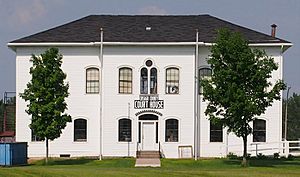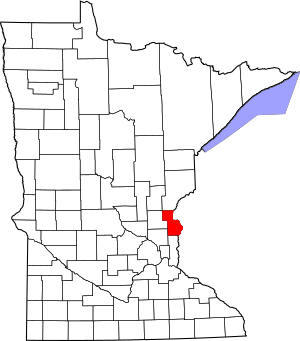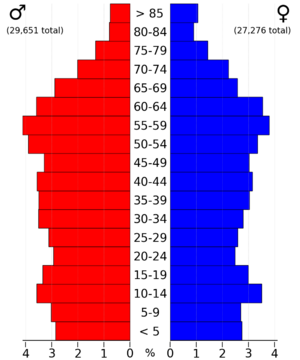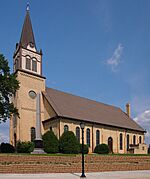Chisago County, Minnesota facts for kids
Quick facts for kids
Chisago County
|
||
|---|---|---|

Old Chisago County Courthouse originally in Center City, Minnesota, moved in 1990 to Almelund, Minnesota.
|
||
|
||

Location within the U.S. state of Minnesota
|
||
 Minnesota's location within the U.S. |
||
| Country | ||
| State | ||
| Founded | September 1, 1851 | |
| Named for | Chisago Lake | |
| Seat | Center City | |
| Largest city | North Branch | |
| Area | ||
| • Total | 442 sq mi (1,140 km2) | |
| • Land | 415 sq mi (1,070 km2) | |
| • Water | 28 sq mi (70 km2) 6.2%% | |
| Population
(2020)
|
||
| • Total | 56,621 | |
| • Estimate
(2023)
|
58,535 |
|
| • Density | 128.10/sq mi (49.46/km2) | |
| Time zone | UTC−6 (Central) | |
| • Summer (DST) | UTC−5 (CDT) | |
| Congressional district | 8th | |
Chisago County (/ʃɪˈsɑːɡoʊ/ shi-SAH-goh) is a county in the east-central part of the U.S. state of Minnesota. The county covers an area of 442 square miles (1,140 square kilometers) and, as of the 2020 Census, had a population of 56,621 people. It is part of the Minneapolis-St. Paul-Bloomington Metropolitan Statistical Area. The county's largest city is North Branch. Within Chisago County is the Chisago Lakes area, which includes the combined areas of Shafer, Chisago City, Lindström, and Center City. Center City is the county seat. The county has a diverse economy, including manufacturing, agriculture, and tourism.
History
Early history
Before the arrival of European settlers, the area that is now Chisago County was home to the Dakota and Ojibwe tribes. The Dakota lived in the southern part of the county and the Ojibwe in the northern part. The first European to explore the area was Sieur duLuth in 1679. French and English trading posts were established in Taylors Falls and Sunrise during the 18th century. In the late 18th and early 19th centuries, French fur traders who traveled south from Lake Superior established trading posts along the river, extending as far south as Taylors Falls.
In 1837, a treaty between the United States and the Chippewa Nation led to the cession of all lands between the St. Croix and Mississippi River, opening the area for European settlement.
European Settlement
The first European settlers arrived in the Chisago County area in the early 1800s. Most of them were of Swedish descent, and they came in search of land and new opportunities. They established small farms and communities throughout the county. Chisago County's early economy was based on farming, logging, and mining. Its forests and mines attracted many settlers to the area. Records of early businesses in Chisago County are recorded in Lindströmsjö. Many Swedes emigrated seeking religious freedom from the oppressive Lutheran Church of Sweden. However, the majority left for reasons other than religious repression and still identified as Lutherans. The early Swedish churches in Minnesota, like the Chisago Lake Evangelical Lutheran Church in Center City, were initially lay-led due to the absence of ordained clergy.
In the mid-1800s, the area that is now Chisago County was part of the Minnesota Territory, and it was not officially established as a county until 1851. It took its name from the Chisago Lake. In its aboriginal form it was "Ki-chi-saga", from two Ojibwe words: "kichi" (large) and "saga" (fair or lovely).
The county seat was originally in Taylors Falls, but was relocated to Chisago City in 1865. It took three more years before the legislature approved this relocation and voters approved it in a referendum. The move was later challenged in the courts on allegations of election fraud, resulting in a two-year delay before the state Supreme Court validated the results. In 1875, the county seat was again moved, this time to Center City where it remains as of 2025.
The development of transportation infrastructure in Chisago County began with the completion of the first bridge across the St. Croix River at Taylors Falls in 1856. Prior to the bridge, ferryboats provided crossings at Sunrise and Rush City. In 1868, a military road was constructed, spanning the entire county from north to south. Railroads soon became a vital mode of transportation, with the completion of the St. Paul and Duluth Railroad, also running north to south, in 1870.
Progressive Era
By the early 1900s and the dawn of the Progressive Era, much of Chisago County's forests had been cleared, leading to the closure of sawmills and the departure of lumberjacks in search of new employment. Advancements in farm machinery enabled fewer workers to manage larger farms. The county's economy shifted toward manufacturing and industry. The county was home to factories and mills, including sawmills, flour mills, and paper mills.
The Progressive Era also led to reform movements resonating throughout Minnesota and Chisago County. The county's distinct approach to education can be primarily attributed to its homogeneous population and the unique structure of local governance. This uniformity allowed the school boards in Chisago County to effectively control external influences through their selection of teachers.
Nearly 70% of Chisago County voters supported Progressive Party candidate Theodore Roosevelt in 1912.
Post-war
Between 1970 and 2000, Chisago County's population surged by 135%. Enhanced transportation networks, including Interstate Highway 35 and U.S. Highway 8, facilitated access to broader regions and led to business and industrial growth.
Modern era
Today, Chisago County has a diverse economy. It is home to several manufacturing companies, including the Anderson Corporation, a major producer of windows and doors. Agriculture is also a large part of the local economy, with crops such as corn, soybeans, and wheat grown in the county. Tourism is also growing, with visitors drawn to the Chisago Lakes area's recreational opportunities.
The county has retained and continues to celebrate much of its Swedish heritage.
Geography
Chisago County lies on Minnesota's eastern border, abutting the western border of Wisconsin (across the Saint Croix River). The Saint Croix flows south-southeast along the county's eastern border. The Sunrise River flows north through the county's central part, collecting the waters of the North Branch Sunrise River and Hay Creek before discharging into the St. Croix at the county's eastern boundary. The county terrain consists of rolling hills, devoted to agriculture. The terrain slopes to the south and east, with its highest point near the northwest corner, at 1,017 ft (310 m) ASL. The county has an area of 442 square miles (1,140 km2), of which 415 square miles (1,070 km2) is land and 28 square miles (73 km2) (6.2%) is water.
Major highways
Adjacent counties
- Pine County - north
- Burnett County, Wisconsin - northeast
- Polk County, Wisconsin - east
- Washington County - south
- Anoka County - southwest
- Isanti County - west
- Kanabec County - northwest
Protected areas
- Fish Lake County Park
- Franconia Bluffs Scientific and Natural Area
- Interstate State Park
- Lawrence Creek Scientific and Natural Area
- Ojiketa Regional Park
- Saint Croix National Scenic Riverway (part)
- Wild River State Park
Climate and weather
| Weather chart for Center City, Minnesota | |||||||||||||||||||||||||||||||||||||||||||||||
|---|---|---|---|---|---|---|---|---|---|---|---|---|---|---|---|---|---|---|---|---|---|---|---|---|---|---|---|---|---|---|---|---|---|---|---|---|---|---|---|---|---|---|---|---|---|---|---|
| J | F | M | A | M | J | J | A | S | O | N | D | ||||||||||||||||||||||||||||||||||||
|
0.9
24
2
|
0.9
31
7
|
1.6
43
19
|
2.8
59
33
|
3.7
70
45
|
4.5
79
56
|
4.4
84
60
|
3.9
81
58
|
3.6
72
49
|
2.8
60
37
|
1.9
42
22
|
1.1
27
8
|
||||||||||||||||||||||||||||||||||||
| temperatures in °F precipitation totals in inches source: The Weather Channel |
|||||||||||||||||||||||||||||||||||||||||||||||
|
Metric conversion
|
|||||||||||||||||||||||||||||||||||||||||||||||
Chisago County has a humid continental climate (Köppen climate classification Dfb) with long, cold winters and warm summers. The average high temperature in the summer is around 80 °F (27 °C), while the average low temperature in the winter is around 5 °F (−15 °C).
A record low of −38 °F (−39 °C) was recorded in January 1977 and a record high of 104 °F (40 °C) was recorded in July 1988.
The county's location in the Upper Midwest region of the United States exposes it to a wide range of weather patterns, including severe thunderstorms, tornadoes, and blizzards. The county experiences moderate precipitation throughout the year, with an average annual rainfall of 30 inches (760 mm) and an average annual snowfall of 47 inches (1,200 mm). Spring is the most active season for severe weather, with thunderstorms and tornadoes common. Winter storms are common during the winter, with heavy snowfall and blizzards.
Chisago County has many lakes and wetlands, which significantly affect its weather and climate. It has over 100 lakes, the largest being North and South Center Lakes, Green Lake, and Chisago Lake. The lakes and wetlands moderate temperatures by absorbing heat during the summer and releasing it during the winter.
Demographics
| Historical population | |||
|---|---|---|---|
| Census | Pop. | %± | |
| 1860 | 1,743 | — | |
| 1870 | 4,358 | 150.0% | |
| 1880 | 7,982 | 83.2% | |
| 1890 | 10,359 | 29.8% | |
| 1900 | 13,248 | 27.9% | |
| 1910 | 13,537 | 2.2% | |
| 1920 | 14,445 | 6.7% | |
| 1930 | 13,189 | −8.7% | |
| 1940 | 13,124 | −0.5% | |
| 1950 | 12,669 | −3.5% | |
| 1960 | 13,419 | 5.9% | |
| 1970 | 17,492 | 30.4% | |
| 1980 | 25,717 | 47.0% | |
| 1990 | 30,521 | 18.7% | |
| 2000 | 41,101 | 34.7% | |
| 2010 | 53,887 | 31.1% | |
| 2020 | 56,621 | 5.1% | |
| 2023 (est.) | 58,535 | 8.6% | |
| U.S. Decennial Census 1790-1960 1900-1990 1990-2000 2010-2020 |
|||
According to the most recent census data, Chisago County's population is 56,621, making it Minnesota's 18th-most populous county. 52.1% of residents are male and 47.9% are female. The average family size in Chisago County was 3.05 persons, and 62.2% of households were married-couple families.
From 1960 to 2010, Chisago County has been one of the state's fastest growing counties. From 2000 to 2014, Chisago County was the fifth-fastest growing county in the state, experiencing a population increase of 12,924 (growth rate of 31.4 percent).
95.4% of residents have at least a high school education, and 22.2% have attained a bachelor's degree or higher. 4.9% are veterans.
Age


Race and ethnicity
Historically, Chisago County has been overwhelmingly populated by non-Hispanic Whites. Since 2000, it has been home to a small but growing Black, Asian, and Hispanic population.
| Year | Total | White alone | Black alone | Hispanic (any race) |
Native alone | Asian alone (incl. Pacific Is.) |
Other race alone |
Two or more |
|||||||
|---|---|---|---|---|---|---|---|---|---|---|---|---|---|---|---|
| Number | % | Number | % | Number | % | Number | % | Number | % | Number | % | Number | % | ||
| 1950 | 12,669 | 12,660 | 99.93 | N/A | N/A | N/A | N/A | N/A | N/A | N/A | N/A | 9 | 0.06 | N/A | N/A |
| 1960 | 13,419 | 13,392 | 99.80 | 21 | 0.16 | N/A | N/A | N/A | N/A | 6 | 0.04 | 0 | 0.00 | N/A | N/A |
| 1970 | 17,492 | 17,427 | 99.63 | 33 | 0.19 | N/A | N/A | N/A | N/A | N/A | N/A | 32 | 0.18 | N/A | N/A |
| 1980 | 25,717 | 25,423 | 98.86 | 28 | 0.11 | 91 | 0.35 | 76 | 0.30 | 59 | 0.23 | 40 | 0.16 | N/A | N/A |
| 1990 | 30,521 | 30,099 | 98.62 | 63 | 0.21 | 137 | 0.45 | 120 | 0.39 | 89 | 0.29 | 13 | 0.04 | N/A | N/A |
| 2000 | 41,101 | 39,953 | 97.21 | 210 | 0.51 | 473 | 1.15 | 187 | 0.45 | 287 | 0.70 | 126 | 0.31 | 327 | 0.80 |
| 2010 | 53,887 | 51,013 | 94.67 | 636 | 1.18 | 835 | 1.55 | 313 | 0.58 | 480 | 0.89 | 19 | 0.04 | 591 | 1.10 |
| 2020 | 56,621 | 50,804 | 89.73 | 845 | 1.49 | 1,451 | 2.56 | 309 | 0.55 | 771 | 1.36 | 185 | 0.33 | 2,256 | 3.98 |
Ancestry
The most common ancestries in Chisago County are German, English, Swedish, Irish and Norwegian.
| Ancestry | Any ancestry | Full ancestry | ||||
|---|---|---|---|---|---|---|
| Rank | Population | % | Rank | Population | % | |
| German | 1 | 19,608 | 34.63 | 1 | 6,551 | 11.57 |
| Irish | 2 | 8,895 | 15.71 | 4 | 1,515 | 2.68 |
| Swedish | 3 | 8,368 | 14.78 | 3 | 2,380 | 4.20 |
| English | 4 | 6,992 | 12.35 | 2 | 2,766 | 4.89 |
| Norwegian | 5 | 6,463 | 11.41 | 5 | 1,467 | 2.59 |
| Polish | 6 | 3,127 | 5.52 | 7 | 637 | 1.13 |
| French | 7 | 2,846 | 5.03 | 9 | 359 | 0.63 |
| Italian | 8 | 1,859 | 3.28 | 8 | 509 | 0.90 |
| Scandinavian | 9 | 1,692 | 2.99 | 6 | 985 | 1.74 |
| Scottish | 10 | 1,239 | 2.19 | 15 | 118 | 0.21 |
| Danish | 11 | 945 | 1.67 | 12 | 144 | 0.25 |
| Dutch | 12 | 908 | 1.60 | 11 | 146 | 0.26 |
| Finnish | 13 | 900 | 1.59 | 10 | 257 | 0.45 |
| Czech | 14 | 884 | 1.56 | 13 | 142 | 0.25 |
| Mexican | 15 | 883 | 1.56 | N/A | N/A | N/A |
| French-Canadian | 16 | 691 | 1.22 | 14 | 139 | 0.25 |
Nativity
In 2021, 97.9% of residents were born in the United States, and 78.5% had been born in Minnesota. Among the foreign-born population, 56.5% were naturalized U.S. citizens. 97.1% of residents spoke only English at home.
From the late 19th to mid-20th century, a majority of the foreign-born population was born in Sweden. As of 2022, the U.S. Census Bureau estimated that 1,174 people were foreign born, or 2.06% of the total population. Of these, about 40% were born in Asia, 30% in Latin America, 15% in Canada, 10% in Europe, and 5% in Africa.
| Country of birth | ||||||||
|---|---|---|---|---|---|---|---|---|
| 1900 | 1930 | 1940 | 1970 | |||||
| Number | % | Number | % | Number | % | Number | % | |
| 4,215 | 84.00 | 2,319 | 84.85 | 1,541 | 82.45 | 220 | 59.46 | |
| 390 | 2.94 | 133 | 4.86 | 92 | 4.93 | 52 | 14.05 | |
| 69 | 1.38 | 94 | 3.44 | 77 | 4.12 | 8 | 2.16 | |
| 128 | 2.55 | 56 | 2.05 | 38 | 2.03 | 16 | 4.32 | |
| 55 | 0.42 | 41 | 1.50 | 40 | 2.14 | 6 | 1.62 | |
| Other | 161 | 3.21 | 90 | 3.29 | 80 | 4.28 | 68 | 18.38 |
| Total foreign born | 5,018 | 100.00 | 2,733 | 100.00 | 1,868 | 100.00 | 370 | 100.0 |
| Country | Number | Percent |
|---|---|---|
| 201 | 17.12 | |
| 178 | 15.16 | |
| 116 | 9.88 | |
| 68 | 5.79 | |
| 64 | 5.45 | |
| 61 | 5.20 | |
| 60 | 5.11 | |
| 51 | 4.34 | |
| 37 | 3.15 | |
| 36 | 3.07 | |
| 30 | 2.56 | |
| 28 | 2.38 | |
| Other | 244 | 20.79 |
| Total | 1,174 | 100.00 |
Religion
The 2020 U.S. Religion Census conducted by the Association of Statisticians of American Religious Bodies found that 7,549 Chisago County residents were affiliated with the Catholic Church, 6,098 with the Evangelical Lutheran Church in America, and 2,975 with the Assemblies of God.
A notable religious building in Chisago County is the Chisago Lake Lutheran Church. The church was founded in 1890 and has been in Center City since 1906. It is part of the Evangelical Lutheran Church in America.
Another prominent religious building in the county is the First United Methodist Church of Lindström. The church has served the community for over 130 years.
The Church of St. Joseph in Taylors Falls is a Catholic church that was founded in 1854. The current building was constructed in 1896.
Transportation
Among workers 16 years and older, 80.3% commuted to work by car, 9.0% carpooled, 1.6% used public transit, and 2.2% walked, biked, or used some other method. 7.0% worked from home. The median household income was $86,900, slightly above the state average. 6.4% of residents lived below the poverty line, and 2.5% were unemployed. 86.4% of housing in the county was owner-occupied.
Education
- Chisago Lakes High School
- North Branch Area High School
- Rush City High School
Communities
Cities
- Center City (county seat)
- Chisago City
- Harris
- Lindström
- North Branch
- Rush City
- Shafer
- Stacy
- Taylors Falls
- Wyoming
Unincorporated communities
Townships
- Amador Township
- Chisago Lake Township
- Fish Lake Township
- Franconia Township
- Lent Township (former, now defunct)
- Nessel Township
- Rushseba Township
- Shafer Township
- Sunrise Township
- Wyoming Township (former, now defunct)
Culture

Chisago County is strongly influenced by the German, Swedish and Norwegian immigrants who settled there in the mid-19th century. It provided the setting for much of Swedish author Vilhelm Moberg's suite of novels The Emigrants in the 1950s, and Moberg engaged in both archival and oral history research for his books to recreate the area's early Swedish immigration. Sculptor Ian Dudley's bronze statue of Moberg stands in Chisago City's park.
Moberg's fictional characters Karl-Oskar and Kristina Nilsson from Ljuder parish in Småland in 1850 with three small children and a group of relatives and neighbors, during the period of the first wave of mass emigration from Sweden.
Moberg penned Karl Oskar as the first to settle around Lake Ki-Chi-Saga (from the Ojibwe Ki-chi-saga-igun, or Gichi-zaaga'igan in contemporary spelling), meaning "big lake with an outlet", which was later shortened to Lake Chisago. The annual Karl Oskar Days in Lindström honor the early settlers' heritage.
See also
 In Spanish: Condado de Chisago para niños
In Spanish: Condado de Chisago para niños



